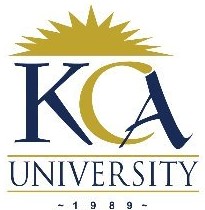 UNIVERSITY EXAMINATIONS: 2012/2013
UNIVERSITY EXAMINATIONS: 2012/2013
THIRD YEAR EXAMINATION FOR THE BACHELOR OF
SCIENCE IN INFORMATION TECHNOLOGY
BIT 3103 FOUNDATIONS OF LEARNING AND ADAPTIVE
SYSTEMS
DATE: DECEMBER, 2012 TIME: 2 HOURS
INSTRUCTIONS: Answer Question ONE and any other TWO
QUESTION ONE
a) Briefly explain the meaning of the following terms in the context of learning and
adaptive systems.
i. Entropy ( 2 Marks)
ii) Machine learning (2 Marks)
iii) Information gain (2 Marks)
b) Explain briefly 2 conditions for stopping building of tree during decision tree
learning. (2 Marks)
c) Distinguish between post pruning and pre-pruning. Describe their importance in
decision tree learning. (3 Marks)
d) Describe the following clustering algorithms as used in learning and adaptive
systems. Give one example for each case (4 Marks)
i) Hierarchical approach
ii) Model-based approach
e) Describe the term „target concept‟ as used in learning and adaptive systems (2 Marks)
f) Explain the difference between inductive learning and instance based learning. Give
one example for each case (4 Marks)
g) Describe any two examples of how case based reasoning can be applied in the
industry (2 Marks)
h) Before the final exam on flas, you decide to evaluate your chances at an “Passed” by
building a decision tree based on prior data. You have the following data items:

i) Compute the entropy of “passed” attribute? (3 Marks)
j) Describe steps of k-nearest neighbour algorithm. Give one example to explain your
answer (4 Marks)
QUESTION TWO
a) Briefly explain the meaning of the term „consistent hypothesis‟ (2 Marks)
b) Briefly explain two conditions for stopping computation of centroids in k- means
algorithm ( 2 Marks)
c) State and explain three main functions of instance based learning algorithms
(6 Marks)
d) Explain the purpose of the following components in a learning system. (4 Marks)
i. Critic
ii. Problem Generator
e) Briefly explain the meaning of the term „weight‟ and its significance in artificial neural
networks (4 Marks)
f) Consider the following table

Compute city block distance between the two people (2 Marks)
QUESTION THREE
a) Briefly explain the following terms
i) Rote learning (2 Marks)
ii) Genetic algorithm (2 Marks)
iii) Reinforcement learning (2 Marks)
b) Briefly explain two limitations of reinforcement learning as used in learning and
adaptive systems (3 Marks)
c) State and explain four elements of reinforcement learning (4 Marks)
d) State and Explain four reinforcement schedules. Give one example for each case.
(4 Marks)
e) Briefly explain three applications reinforcement learning in the industry (3 Marks)
QUESTION FOUR
a) Explain the meaning of the following terms
i. Mutation (2 Marks)
ii. Permutation Encoding (2 Marks)
iii. Fitness Score (2 Marks)
b) Briefly explain any four properties of genetic algorithms (4 Marks)
c) State and explain each of these operators. Give one example for each case (6 Marks)
d) Describe the steps followed by genetic algorithm in machine learning (4 Marks)
QUESTION FIVE
a) Briefly explain the following terms.
i) Dendrites (2 Marks)
ii) Perception (2 Marks)
b) Briefly explain four criteria of evaluating a learning algorithm (4 Marks)
c) Briefly explain how information flow in a neuron (4 Marks)
d) Distinguish between activation neuron and summation function as used in artificial
neural networks. Give one example for each case (4 Marks)
e) Briefly explain any four benefits of artificial applications of learning and adaptive
systems in modern organizations (4 Marks)